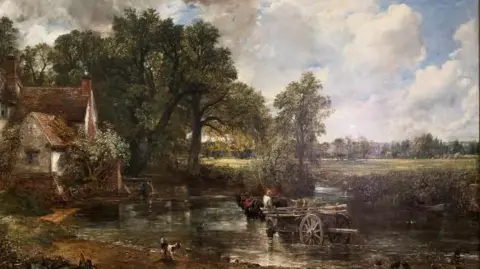 John Fairhall/BBCThe Hay Wain was considered radical when it was first displayed in 1821An exhibition focussing on the work of renowned landscape artist and one of his most celebrated works is to open.
John Fairhall/BBCThe Hay Wain was considered radical when it was first displayed in 1821An exhibition focussing on the work of renowned landscape artist and one of his most celebrated works is to open.
The iconic Hay Wain oil painting by the Suffolk-born artist John Constable is the main focus of a new exhibition at The National Gallery in London.
Painted in 1821, it was considered "radical" at the time and only became a sensation in the art world after winning a gold medal at the Paris Salon in 1824.
The Discover Constable and The Hay Wain exhibition, part of the gallery's bicentenary celebrations, also includes sketches by the painter that span 20 years that he used to create the finished painting.
The Hay Wain depicts the Suffolk countryside and features horses pulling a wood wain, or large farm waggon, across a millpond.
Per Rumberg, head of curatorial department at the National Gallery, described Constable's style as "quietly radical".
He said: "I'm really excited to have the exhibition here because The Hay Wain is arguably the most celebrated, most beloved picture by Constable and one of the highlights of the collection of the National Gallery.
"And in this exhibition, it gives us the opportunity to contextualise it, to celebrate it for what it is, what it was at the time, and what it has become over time."
 John Fairhall/BBCPer Rumberg says the Hay Wain is "arguably the most celebrated, most beloved picture by Constable"The painting was a "very carefully constructed work", which Constable painted in London, Mr Rumberg said.
John Fairhall/BBCPer Rumberg says the Hay Wain is "arguably the most celebrated, most beloved picture by Constable"The painting was a "very carefully constructed work", which Constable painted in London, Mr Rumberg said.
"The Hay Wain, when it was first shown in 1821, wasn't really well received at all, and it wasn't until a few years later, when the picture was shown in the Salon in Paris, that it was recognised as one of the most important landscape pictures.
"And he was given the golden medal in Paris, so you could argue the French really appreciated him more," he added.
He said the exhibition tries to contextualise the picture, showing the finished work alongside the various sketches that led to it.
 John Fairhall/BBCChristine Riding says the gallery's bicentenary was a "fantastic opportunity" to stage the exhibitionChristine Riding, curator of the exhibition said: "It's 200 years since the National Gallery was founded, and it's also 200 years since Constable achieved international recognition through winning a gold medal at the Paris salon in 1824.
John Fairhall/BBCChristine Riding says the gallery's bicentenary was a "fantastic opportunity" to stage the exhibitionChristine Riding, curator of the exhibition said: "It's 200 years since the National Gallery was founded, and it's also 200 years since Constable achieved international recognition through winning a gold medal at the Paris salon in 1824.
"And we actually have the gold medal as part of the exhibition."
She said it was the first time the gallery had staged a lone exhibition about Constable.
"It just seemed like a fantastic opportunity to celebrate our birthday and celebrate an artist who has now become absolutely central to British, European and international art," Ms Riding explained.
Born in 1776 in East Bergholt, Constable is best known for his depiction of the English countryside, particularly his native Suffolk.
Listen: The mill at Flatford is home to the Field Studies CouncilFollow Suffolk news on BBC Sounds, Facebook, Instagram and X.
Dallas News Roundup: Keeping You Informed on Local Developments
